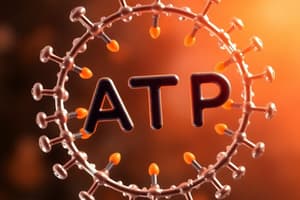Podcast
Questions and Answers
Which of the following statements accurately describes the role of ATP in cellular processes?
Which of the following statements accurately describes the role of ATP in cellular processes?
- ATP serves as the primary energy currency, powering various cellular activities. (correct)
- ATP stores genetic information necessary for protein synthesis.
- ATP facilitates the transport of oxygen within the bloodstream.
- ATP primarily functions as a structural component of cell membranes.
What is the fundamental difference between potential and kinetic energy?
What is the fundamental difference between potential and kinetic energy?
- Potential energy is associated with motion, while kinetic energy is stored energy.
- Potential energy is released as heat, while kinetic energy is used to create chemical bonds.
- Potential energy is stored energy, while kinetic energy is the energy of motion. (correct)
- Potential energy can be created, while kinetic energy can be destroyed.
According to the first law of thermodynamics, which of the following statements is true regarding energy transformations?
According to the first law of thermodynamics, which of the following statements is true regarding energy transformations?
- Energy can be transformed from one form to another, but the total amount of energy remains constant. (correct)
- Energy transformations always result in a net increase in usable energy.
- Energy is constantly being created and destroyed in closed systems.
- Energy transformations occur without any loss as heat.
Which type of chemical reaction involves the breakdown of a larger molecule into smaller molecules or atoms?
Which type of chemical reaction involves the breakdown of a larger molecule into smaller molecules or atoms?
In an oxidation-reduction (redox) reaction, what process occurs when a molecule loses electrons?
In an oxidation-reduction (redox) reaction, what process occurs when a molecule loses electrons?
What distinguishes an anabolic reaction from a catabolic reaction?
What distinguishes an anabolic reaction from a catabolic reaction?
Which of the following best describes an exergonic reaction?
Which of the following best describes an exergonic reaction?
In the context of chemical reactions, what does it mean for a reaction to be classified as 'reversible'?
In the context of chemical reactions, what does it mean for a reaction to be classified as 'reversible'?
Which of the following is the MOST accurate description of activation energy?
Which of the following is the MOST accurate description of activation energy?
How does an enzyme accelerate a biochemical reaction?
How does an enzyme accelerate a biochemical reaction?
What is the immediate result of a substrate binding to an enzyme's active site?
What is the immediate result of a substrate binding to an enzyme's active site?
Pepsin, an enzyme found in the stomach, functions optimally at a pH of around 2. What is the MOST likely outcome if pepsin were placed in an environment with a pH of 7?
Pepsin, an enzyme found in the stomach, functions optimally at a pH of around 2. What is the MOST likely outcome if pepsin were placed in an environment with a pH of 7?
In competitive inhibition, what directly blocks the substrate from binding to the enzyme?
In competitive inhibition, what directly blocks the substrate from binding to the enzyme?
How does a noncompetitive inhibitor affect enzyme activity?
How does a noncompetitive inhibitor affect enzyme activity?
How do high levels of ATP (adenosine triphosphate) regulate metabolic pathways?
How do high levels of ATP (adenosine triphosphate) regulate metabolic pathways?
What is the MOST significant difference between a catalyzed and uncatalyzed reaction?
What is the MOST significant difference between a catalyzed and uncatalyzed reaction?
Flashcards
Reaction Rate
Reaction Rate
The speed at which reactants are converted to products.
Activation Energy
Activation Energy
The minimum energy required to start a chemical reaction.
Catalyzed Reaction
Catalyzed Reaction
A reaction that occurs faster due to the presence of a catalyst.
Uncatalyzed Reaction
Uncatalyzed Reaction
Signup and view all the flashcards
Enzyme Function
Enzyme Function
Signup and view all the flashcards
Active Site
Active Site
Signup and view all the flashcards
Competitive Inhibition
Competitive Inhibition
Signup and view all the flashcards
Metabolism
Metabolism
Signup and view all the flashcards
Structure of ATP
Structure of ATP
Signup and view all the flashcards
Function of ATP
Function of ATP
Signup and view all the flashcards
Hydrolysis of ATP
Hydrolysis of ATP
Signup and view all the flashcards
Potential Energy
Potential Energy
Signup and view all the flashcards
Kinetic Energy
Kinetic Energy
Signup and view all the flashcards
First Law of Thermodynamics
First Law of Thermodynamics
Signup and view all the flashcards
Anabolic Reactions
Anabolic Reactions
Signup and view all the flashcards
Exergonic Reactions
Exergonic Reactions
Signup and view all the flashcards
Study Notes
ATP Structure and Function
- ATP (adenosine triphosphate) is the primary energy currency of cells
- ATP consists of an adenine base, a ribose sugar, and three phosphate groups
- Phosphate groups are connected by high-energy bonds
- Energy is stored in the bonds between phosphate groups
- ATP releases energy when hydrolyzed to ADP (adenosine diphosphate) and inorganic phosphate (Pi)
ATP Function
- ATP provides energy for various cellular processes, including muscle contraction, transport, and chemical reactions
Energy Storage and Release
- ATP stores energy in the bonds between phosphate groups
- Energy is released when ATP is hydrolyzed to ADP and inorganic phosphate (Pi)
Potential and Kinetic Energy
- Potential energy is energy due to position or structure (e.g., energy in chemical bonds)
- Kinetic energy is energy of motion (e.g., moving particles, heat)
- The laws of thermodynamics govern energy transformations
- First Law: energy cannot be created or destroyed, only transformed
- Second Law: energy transformations are inefficient, and some energy is always lost as heat, increasing entropy
Types of Chemical Reactions
- Synthesis reactions: Two or more reactants combine to form a larger molecule
- Decomposition reactions: A large molecule is broken into smaller molecules or atoms
- Exchange reactions: Bonds are broken and reformed as reactants are rearranged
- Oxidation-reduction (redox) reactions: Involve the transfer of electrons, involving oxidation (loss of electrons) and reduction (gain of electrons)
Reaction Classification
- Anabolic reactions: Build complex molecules from simpler ones (require energy)
- Catabolic reactions: Break down complex molecules into simpler ones (release energy)
- Endergonic reactions: Require energy input
- Exergonic reactions: Release energy
- Reversible reactions: Can proceed in both forward and reverse directions
- Irreversible reactions: Proceed in only one direction
Reaction Rate, Activation Energy, Catalyzed and Uncatalyzed Reactions
- Reaction rate: Speed at which reactants are converted to products
- Activation energy: Minimum energy required to start a reaction
- Catalyzed reaction: Reaction accelerated by a catalyst (e.g., enzyme)
- Uncatalyzed reaction: Reaction that occurs without a catalyst
Enzymes
- Enzymes are proteins with a specific 3D shape, which has an active site where substrates bind
- Function: Lower activation energy, speeding up biochemical reactions
- Effects of substrate concentration, temperature, and pH on reaction rates
- Mechanism:
- Substrate binds to the enzyme's active site
- Enzyme-substrate complex forms; lowers activation energy
- Products are released; enzyme unchanged
Enzyme Inhibition
- Competitive inhibition: Inhibitor binds to the active site, blocking substrate binding
- Noncompetitive inhibition: Inhibitor binds to a different site (allosteric site), changing the enzyme's shape and reducing activity
Metabolism
- Metabolism: Sum of all chemical reactions in a cell or organism
- Metabolic pathways are examples of negative feedback, where the product inhibits the earlier steps to regulate pathway activity
Studying That Suits You
Use AI to generate personalized quizzes and flashcards to suit your learning preferences.




